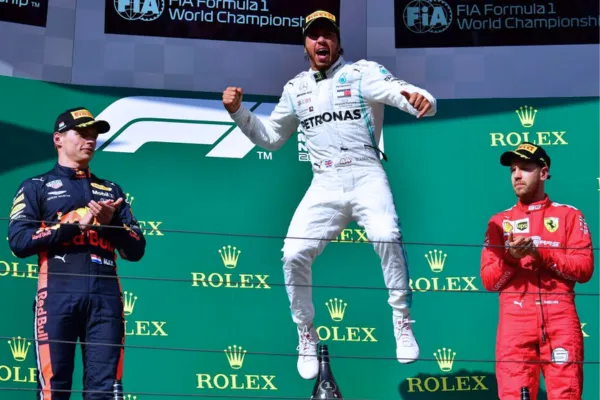
The Anatomy of a Champion’s Decision: What Leaders Can Learn from Lewis Hamilton’s 2020 Turkish GP
Introduction: Beyond Horses and Strategy
Turkey, November 15, 2020. Lewis Hamilton started the Turkish Grand Prix on worn intermediate tires, yet defied odds to win his seventh world championship. Engineers called his performance "mathematically impossible"; Hamilton described it as “listening to the car.” He adapted through 50 treacherous laps, balancing braking, throttle, and mindset under conditions few could imagine turning grit and intuition into a storied victory.
This victory wasn't about superior machinery, it was about unshakable character, relentless attitude, and adaptive mindset. Traits every transformative leader can learn from.
Introduction: Beyond Horses and Strategy
The Three Pillars of Unshakeable Leadership
2. Attitude: Energy as Strategic Fuel
3. Mindset: The Adaptation Imperative
Three Leadership Development Levers
Structural Summary: Leadership Lessons from Turkey GP
The Three Pillars of Unshakeable Leadership
Champions lead not with data alone, but through three invisible yet essential build blocks:
Character: Grit and integrity under stress
Attitude: Framing energy into strategy
Mindset: Adaptation as a default
1. Character: The Grit Gap

True leadership shows in how we carry the weight of decisions when the terrain is steep.
Hamilton didn’t win because he had fresher tires; he won on sheer perseverance. He ignored pit instructions because he trusted his capabilities and deep learning. That kind of grit harboring toughness while staying self-aware is a leadership linchpin.
Business parallel: In 2018, Satya Nadella led Microsoft's $20 billion bet on AI well before mainstream recognition. He later told Bloomberg, "You need irrational confidence in your vision." That belief didn’t come without scrutiny, but Nadella's conviction laid the foundation for Microsoft’s AI dominance.
Actionable Insight: In interview processes, ask:
“Tell me about a situation where you bet on yourself despite doubt from others. What was the outcome?”
This separates those who act versus those who follow.
2. Attitude: Energy as Strategic Fuel
Hamilton’s victory radio call
“That’s for every kid who dreams the impossible.”
did more than win admiration; it demonstrated leadership with empathy, reframing his grit as collective inspiration. Like Elon Musk or Sundar Pichai, he wasn’t just pushing limits he was inviting others to believe.
Positive energy connects performance to purpose a crucial predictor of loyalty and engagement. Gallup data shows that high-enthusiasm leaders spark up to 18% higher team performance, compared to disengaged peers.
Actionable Tool: End your team meetings by sharing a "win for the team"—even minor—forged from collective effort.
3. Mindset: The Adaptation Imperative

50 laps of micro-decisions in a storm, where mindset becomes the difference between survival and supremacy.
Hamilton’s tire management mirrored AWS’s response to the COVID surge: pivot rapidly and scale strategically. As Amazon’s Andy Jassy did in 2020 doubling AWS capacity in months. Hamilton made micro-adjustments to throttle, braking, and line across 50 wet laps, evolving from intermediate to slick tire performance.
Adaptation isn't reactive it’s wired in. Leaders who fail to pivot often lead teams into irrelevant or broken strategies.
Actionable Habit: Begin each Monday by asking:
“What’s changed since last week? What new course correction should we test this week?”
Can You Train Leadership DNA?

Modern leaders train like elite athletes, rewiring the brain to respond, not react.
After losing the 2016 title, Hamilton hired a performance neuroscientist to reshape his response to setbacks. Since then, he has added four more championships. That is proof: elite performance isn’t innate it’s trainable.
Why this matters: Neuroscience research shows consistent cognitive training boosts emotional regulation, focus under pressure, and decision stamina. For example, experienced leaders in studies outperform peers in reacting to crisis by +30% faster and with 50% fewer errors.
Here’s how to build your champion brain:
Three Leadership Development Levers
1. Simulate the Unthinkable
Mercedes’ “tire catastrophe” drills replicate high-stress, unknown environments.
Your move: Run “Black Swan Workshops” e.g.,
"Your CTO quits two days before kick-off."
During these drills, ask explicit questions:
How do you respond?
Who leads?
What’s Plan B?
2. Reframe Failure
Hamilton reviews race losses before celebrating wins, always seeking learning.
Try this: At the end of each sprint, run a Loss Debrief asking “What patterns emerged?” Rule: No justification just insight.
3. Measure the Invisible
Hamilton’s team tracks his “focus endurance” via biometric data (heart rate, skin response). Adapt for your team: Track a Decision Stamina Index how many high-stakes decisions your team can make before quality declines? You’ll discover patterns and see returns from rest, delegation, and support.

Champion leadership shows up in presence before it ever does in performance. This is what preparation looks like.
Structural Summary: Leadership Lessons from Turkey GP

The Finish Line: Why This Matters
In business, like racing, margins are measured in moments:
Character tells us what we do when systems fail
Attitude tells us how we stay principled under pressure
Mindset tells us how we adapt when everything changes
Training ensures we own our reactions before chaos hits
When Hamilton heard "critical" about his tires, he didn’t see excuses, he heard opportunities. Ask yourself:
When your team's "tires" are failing, do leaders see gaps or make excuses?
What You Can Do Today
Add Grit Questions to Hiring Rubrics Ask proactive, personal questions that test conviction.
Launch Loss Debriefs
Use a 15-minute structured review: context, trigger, insight.Run One Black-Swan Drill Quarterly
Create scenarios that test adaptation under ambiguity.Track Decision Stamina
Have leaders self-rate their focus quality post high-stress calls.
Final Thought:
Champions aren’t born they’re refined. And while horsepower helps, leadership grit, attitude, adaptability, and brain training define legends.
Hamilton’s seventh title wasn’t an accident it was the result of preparation meeting pressure. Your move: When chaos hits, does your team default to panic… or to steady, strategic action?
Let me know if you'd like a turnkey “Champion Decision-Making” workshop for your leadership team or branded Loss Debrief guides!

